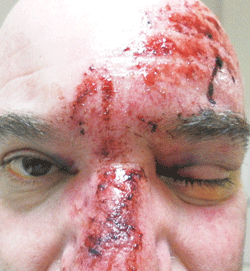 Hopefully, none of us will ever need to rely on our vehicle’s airbag system. Driving can be a hazardous activity, but airbags have become a crucial element for improving driver and passenger safety on our roadways. First mandated in 1984, it is estimated that tens of thousands of American lives have been saved by these devices over the last 30 years. In 2010 alone, an estimated 2,306 deaths were averted because of frontal airbags.1
Hopefully, none of us will ever need to rely on our vehicle’s airbag system. Driving can be a hazardous activity, but airbags have become a crucial element for improving driver and passenger safety on our roadways. First mandated in 1984, it is estimated that tens of thousands of American lives have been saved by these devices over the last 30 years. In 2010 alone, an estimated 2,306 deaths were averted because of frontal airbags.1
Yet, despite their life-saving potential, airbag systems have the capacity to induce significant collateral damage. Consider the mechanism of airbag deployment: In order to facilitate device inflation, a solid propellant (sodium azide) is ignited by an electrical charge and converted to rapidly expanding hydrocarbon gases, filling the woven nylon “cushion” within 50 milliseconds of impact.2 Essentially, the deployment system is similar to the pyrotechnic bursts used at sporting events and rock concerts, but in a much smaller, more confined area. Hence, drivers and passengers encountering such a situation may experience at least three unique types of injury.
Obviously, the first is blunt force trauma. As the airbag explodes at speeds approaching 150mph, the victim simultaneously is driven forward into the device. The resulting facial or ocular trauma can yield damage comparatively similar to that caused by a fist or a baseball.3 The second form of trauma involves laceration or penetrating injury. This occurs when an object in close proximity to the victim’s face—such as a pair of spectacles—is thrust forward and perforates the tissue. Finally, the explosive nature of the deployment system itself creates the potential for both thermal and chemical burns to the face and eyes.3,4
As primary eye care providers, optometrists may well be the first individuals to encounter ocular injury associated with motor vehicle accidents (MVA), including those secondary to airbag deployment.
Examine the Patient
When MVA patients first present, it is important to assess the situation grossly by inspecting the individual’s general appearance. Address several pertinent questions: Is there swelling or bruising to the periorbital area? Is there a wound indicative of penetrating injury? Is there evidence of a burn injury to the skin?
Then, carefully examine the ocular posture as well as the plane of the globes. Does one eye appear to be lower than the other, or sunken into the orbit? Is there diplopia? These signs could be suggestive of a blowout fracture, which requires radiologic imaging and possibly surgical repair. Palpation of the orbital rim may further reveal a step-down fracture, crepitus or localized paresthesia due to trigeminal nerve damage.

This patient sought care in our clinical center after sustaining blunt facial trauma and chemical burns following vehicular airbag deployment.
Next, examine the eyes themselves. Often, they may be partially or completely swollen shut due to edema and ecchymosis. If the patient resists you holding his or her eye open because of sensitivity, ask him or her to open the eye for you. Evaluate the damage to the anterior segment and obtain visual acuity, including corrected or pinhole acuity. This is crucially important, particularly for medicolegal purposes. Be aware that the patient eventually may be involved in a personal injury lawsuit. Establishing initial acuity after any sort of trauma not only sets the stage for recovery and realistic expectations, but also documents where a patient’s clinical journey has begun.
Also, be sure to check ocular motility. But, don’t be too concerned if the patient initially is diplopic or shows a generalized restriction of movement in the involved eye. Post-traumatic swelling of the orbital contents can hinder ocular motility to some degree; however, this often resolves completely within a week or so. Look for specific motility deficits, such as an inability to elevate, depress, adduct or abduct the eye. This can be an indication of nerve damage or, more likely, muscle entrapment.
Slit lamp evaluation and funduscopy also are crucial in any case of ocular trauma. Some of the more common disorders associated with airbag injury include eyelid laceration, corneal abrasion, uveitis, hyphema, angle recession and lens dislocation. Damage to the posterior segment can result in vitreous or retinal hemorrhage, commotio retinae, retinal tear or detachment, and macular hole formation.5
Further, while uncommon, global rupture or scleral or corneal perforation can result from airbag injuries. Be certain that the globe is not compromised before attempting any manipulation of the eye. Ensure that the anterior chamber is formed, and that there is no fluid leakage or uveal tissue exposure.
Once the integrity of the eye has been established, perform a systematic evaluation of the ocular structures from front to back. And, always dilate the pupil unless a contraindication is observed (e.g., a dislocated lens). Tonometry should be performed if the globe is intact, but gonioscopy to rule out angle recession typically is not conducted until evidence of healing has been documented at a subsequent visit.
Ocular injury can be caused by a host of sources. Ironically, one of the greatest innovations designed to limit the severity of bodily harm—the vehicle airbag—represents a great potential hazard to ocular health. Being able to understand, recognize and promptly address the sequelae of airbag-related ocular injuries is essential for the comprehensive or medically oriented optometrist.
1. Traffic Safety Facts: 2010 Data. National Highway Traffic Safety Administration. Available at:
www-nrd.nhtsa.dot.gov/Pubs/811619.pdf. Accessed January 17, 2013.
2. Barnes SS, Wong W Jr, Affeldt JC. A case of severe airbag related ocular alkali injury. Hawaii J Med Public Health. 2012 Aug;71(8):229-31.
3. Kenney KS, Fanciullo LM. Automobile air bags: friend or foe? A case of air bag-associated ocular trauma and a related literature review. Optometry. 2005 Jul;76(7):382-6.
4. Lehto KS, Sulander PO, Tervo TM. Do motor vehicle airbags increase risk of ocular injuries in adults? Ophthalmology. 2003 Jun;110(6):1082-8.
5. Ball DC, Bouchard CS. Ocular morbidity associated with airbag deployment: a report of seven cases and a review of the literature. Cornea. 2001 Mar;20(2):159-63.
6. Rihawi S, Frentz M, Schrage NF. Emergency treatment of eye burns: which rinsing solution should we choose? Graefes Arch Clin Exp Ophthalmol. 2006 Jul;244(7):845-54.
7. Davis AR, Ali QK. Topical steroid use in the treatment of ocular alkali burns. Br J Ophthalmol. 1997 Sep;81(9):732-4.
8. Clare G, Suleman H, Bunce C, Dua H. Amniotic membrane transplantation for acute ocular burns. Cochrane Database Syst Rev. 2012 Sep 12;9:CD009379.
Carefully
debride any loose, necrotic tissue from the lids or ocular surface that
would serve to delay healing. This is best performed using a
cotton-tipped applicator, spatula or spud. Sweep the conjunctival
fornices to ensure that there is no residual particulate matter located
in the superior or inferior cul-de-sac.
Treat
periocular skin lesions by cleaning the area thoroughly with an
antiseptic solution (e.g., povidone-iodine 10%) and applying a
prophylactic antibiotic ointment, such as bacitracin 500 U/g QID. For
more severe burns, silver sulfadiazine 1% cream is more appropriate and
may be better tolerated. For patients who exhibit significant pain,
consider the use of prescription narcotic analgesic agents, such as
hydrocodone/acetaminophen 5mg/300mg q4h for the first 24 to 48 hours. Alkali
injuries carry a guarded prognosis. These solutions saponify the fatty
units of the cornea and other ocular tissues, thereby destroying the
cell structure—not only of the epithelium, but also of the underlying
stroma. While acids create an initial burn and then stabilize, alkalis
may continue to penetrate into the eye long after the initial trauma.
Treat
chemical burns to the cornea intuitively. Employ a strong cycloplegic
agent (e.g., 0.25% scopolamine BID) and a broad-spectrum antibiotic
(e.g., 0.5% moxifloxacin TID) for prophylaxis. Treat concurrent uveitis
with a topical corticosteroid, used judiciously during the first week
following trauma (e.g., 0.05% difluprednate QID or 1% prednisolone
acetate q2h). Be aware, however, that prolonged steroid use (>10
days) in cases of alkali injury raises the possibility of a corneal
melt.7 Chemical ocular burns need to be monitored daily as
the cornea re-epithelializes, as well as periodically thereafter for
potential IOP elevation. Severe burns that fail to respond to
conventional therapy may warrant consideration for amniotic membrane
transplantation.8
The Danger of Chemical Burns
One of the most crucial management
considerations in dealing with airbag injuries is addressing associated
ocular and facial burns. Hot gases can escape from deployed airbags, as
can the particulate contents of the airbag itself (e.g., sodium
hydroxide, sodium carbonate and other metallic oxides), which can lead
to alkali injuries of the ocular and periocular tissue. Administer
copious irrigation for thermal and chemical burns. Liberally rinse the
area with saline for a minimum of 15 minutes with at least one liter of
solution.6 Also, test with pH paper to ensure neutrality in cases of chemical injury.

